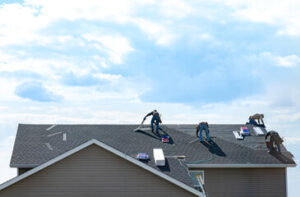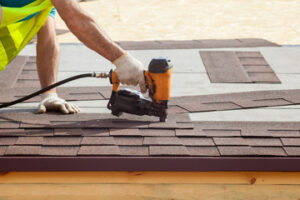Roofing is a challenging and exciting form of building construction. There are 64 practical roof types that require a skilled team of workers to make, repair, or replace.
A roof is more than just the outer surface of your house; it also includes a system of components that work together to protect the home. Understanding these parts is essential for repairing and maintaining your roof. Contact Arthur’s Roofing now!

There are many different materials that can be used for roofing, each with its own advantages and disadvantages. The type of material chosen for a roof can significantly impact the cost, durability, waterproof protection and insulation needs of the building, as well as its aesthetics. When selecting a roofing material, it is important to consider all of these factors carefully.
The most common types of roofing materials are shingles, shakes and tar-and-asphalt flat membranes. Shingles are thin, wedge-shaped pieces of wood that can be made from a variety of materials, including asphalt and mineral composites that create various colors. They are one of the most popular roofing materials for both residential and commercial buildings, and come in a wide variety of shapes and styles.
Shakes are thicker, slab-like pieces of wood that are split rather than sawed to produce a more textured surface. They are usually a better choice than shingles for high-wind areas, and can be treated to resist insect infestation and fire. They are also a good option for preserving natural wood beauty in the home, and can be stained or painted to match any exterior.
Membrane roofs are made from either a synthetic rubber, thermoplastic or a modified bitumen and are designed for flat or low-sloped commercial and industrial roofs. They are extremely durable and resistant to both sunlight and rain, and can be designed with built-in insulation for energy efficiency.
Another type of roofing is tile, which offers a traditional look that can complement many architectural styles. Tile can be glazed or unglazed, and comes in a wide variety of colors and textures. Some tiles are reflective and help reduce heating costs in warmer climates by preventing the absorption of solar heat.
The framework of a roof is typically constructed from rafters or premade trusses, depending on the design of the building. The sheathing is then installed, which can be plywood or oriented strand board (OSB). A moisture barrier is also sometimes added as an underlayment, to prevent water damage during construction and the early stages of a roof’s life.
Installation
A roof is essential to a building because it protects the space inside from weather and the elements. It also provides comfort for the inhabitants and preserves the structural integrity of the space. To achieve this, the roofing must be installed properly to prevent leaks and damage.
Roofing is installed using various methods depending on the needs of the home. For example, valleys are waterproofed with underlayment and felt paper. The shingles are then installed on top of the underlayment and felt paper. This is to ensure that water doesn’t get into the space between the shingles and the roof deck.
The installation of roofing is a hazardous process that requires safety precautions such as hard hats and ladders to avoid injuries or accidents. It is also important to protect the surroundings with tarps to prevent debris from damaging the landscaping and drains.
Maintenance
A roof protects a home from the elements and provides a vital barrier against water damage. It is also an important part of a building’s aesthetic. Proper roofing maintenance is essential for preserving the integrity of a residential or commercial structure, and it can help avoid costly repairs and extend the lifespan of the roof.
During routine inspections, look for shingle deterioration and note any areas that are missing or blown off the roof. Also inspect the flashing, which seals the area where the roof meets other surfaces, such as chimneys and skylights. Re-caulking or replacing deteriorated flashing is a simple repair that prevents water from entering the home. Inspect vent pipes, as they can also leak when caulking deteriorates or is damaged. Look for moss or algae, which indicate that moisture is trapped beneath the shingles and can lead to material decay, and remove any organisms as they appear.
Trimming tree limbs near the roof is another easy but important preventative measure. Heavy storms and natural disasters can cause tree limbs to fall, which can damage or puncture the roof. Keeping branches trimmed away from the roof reduces the risk of damage and also helps prevent animals from accessing the roof. Fall is the ideal time to conduct regular residential roof maintenance, as this work can be done easily with relatively low temperatures and no mud or debris.
Materials
There are many roofing materials from which homeowners can choose, and finding the right one is more than just a matter of cost. The best material for your home will depend on several factors, including longevity, aesthetics, and the ability to withstand weather extremes.
Asphalt shingles are one of the most common roofing materials for homes across North America, and come in a variety of looks. They are typically made from a fiberglass base topped with mineral and asphalt granules. The most popular shingle styles include 3-tab, dimensional and luxury asphalt shingles. In addition to their aesthetic appeal, these shingles are easy to install and offer an excellent level of protection for most types of home roofs.
Another great option is a metal roof. Metal shingles and shakes are fabricated from stamped metal and finished with either a high-quality baked-on coating or mineral granules. They can be crafted to look like traditional asphalt shingles, wooden shakes, slate or clay tiles. These roofs can last 30 to 50 years and are a good choice when appearance is a priority.
Flat roofs are a challenge for most roofing professionals, as they require unique installation techniques and often have different requirements than sloped roofs. Depending on the roofing type, flat roofs can be built from single-membrane systems such as EPDM rubber roofing, PVC roofing or thermo-polyolefin (TPO) roofing. Other popular roofing options include built-up roofs (BUR) and modified bitumen membranes.
Natural roofing materials like clay or slate are beautiful and durable, but they can be quite expensive. These materials also need a substantial amount of maintenance to keep them looking beautiful and functioning properly.
Wood shingles and shakes are a more affordable option that offers a beautiful, rustic look. They are available in a variety of sizes and shapes and can be cut to fit nearly any type of roof. However, these roofing materials are not suitable for areas prone to moisture or wildfires, and they may require extra support due to their weight. In addition, they can be difficult to work on and may not provide adequate insulation for colder climates.
Installing
Whether replacing an existing roof or installing a new one, the first step is to prepare the job site. This includes tarping the surrounding areas to protect landscaping and other structures from roofing debris, covering windows and doors with tarps to prevent them from being damaged during construction, and hauling in roll-off dumpsters to accommodate the construction waste. It is also a good idea to cover any open drains to prevent small pieces of debris from getting trapped and blocking the drain.
Once the jobsite is ready, the roofing contractor will begin removing any existing materials from the roof. This is usually done by hand, but can also be accomplished with a roofing shovel or pry bar. It is important to remove the old material carefully so as not to damage the underlying structure. Then the installation process can begin.
In addition to shingles, the roofing contractor will install any vents and/or insulation. These are important to keep the attic and other spaces cool, as well as to help with energy efficiency. Vents can include gable vents, ridge vents, and attic ventilators. Insulation may include foam board, mineral wool, or spray-in foam.
Other important elements of a good roof include flashing and valleys. These are the areas that connect the slopes of a roof and form a “V” shape. They need to be waterproofed using underlayment and felt paper. The roofer will also add flashing around chimneys, wood stove pipes, certain vents, and along hip roofs.
Roofing is dangerous work, so the installation process should be carried out by qualified, experienced professionals. It is also a good idea to use proper safety equipment, including rubber-soled boots or shoes, gloves, eye protection, and a hard hat. Finally, it is recommended that a multi-layered approach to fall prevention and protection be implemented on roofing projects, including safety plans, ladder safety mobile applications, infographics, tipsheets, toolbox talks, and more.

